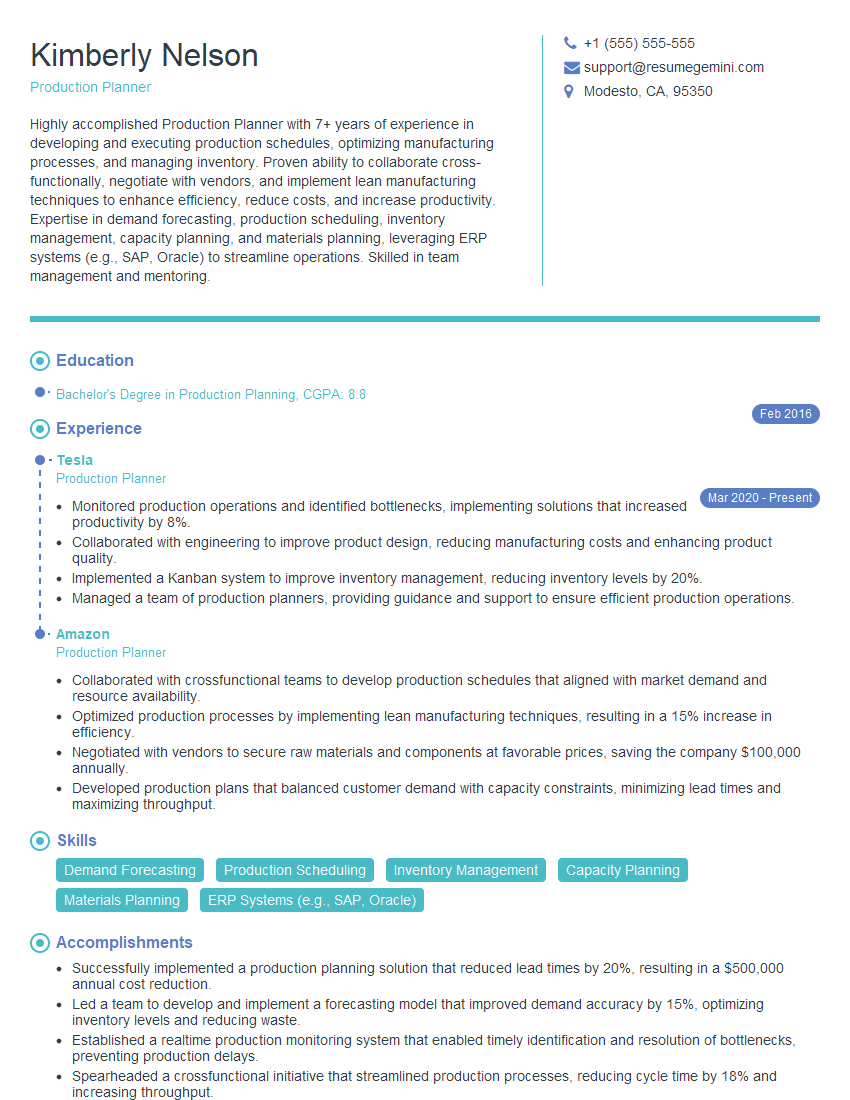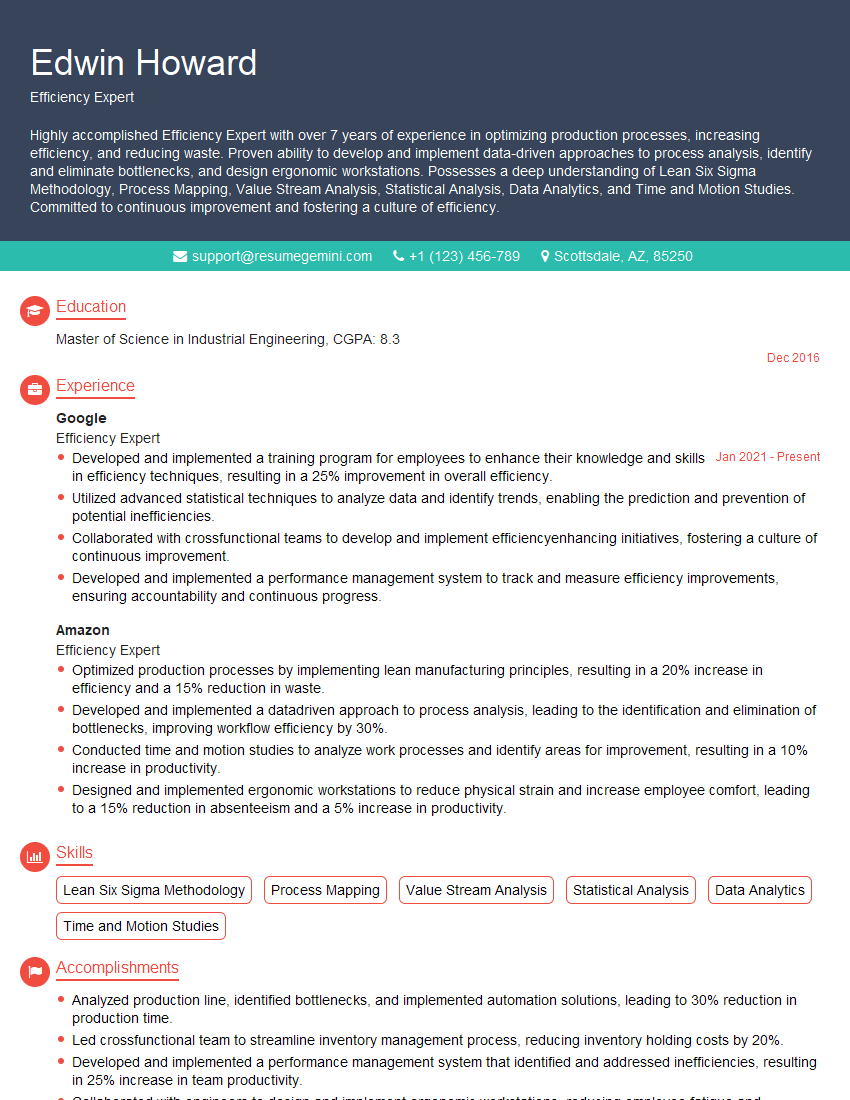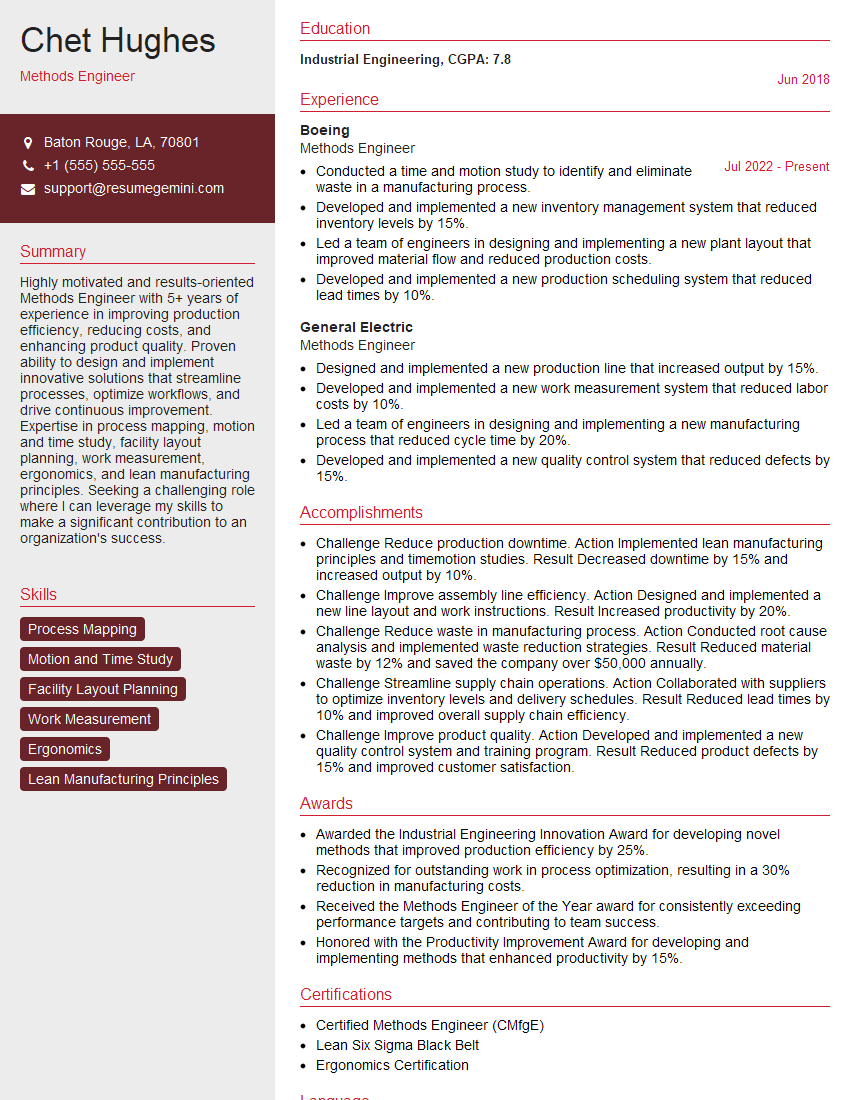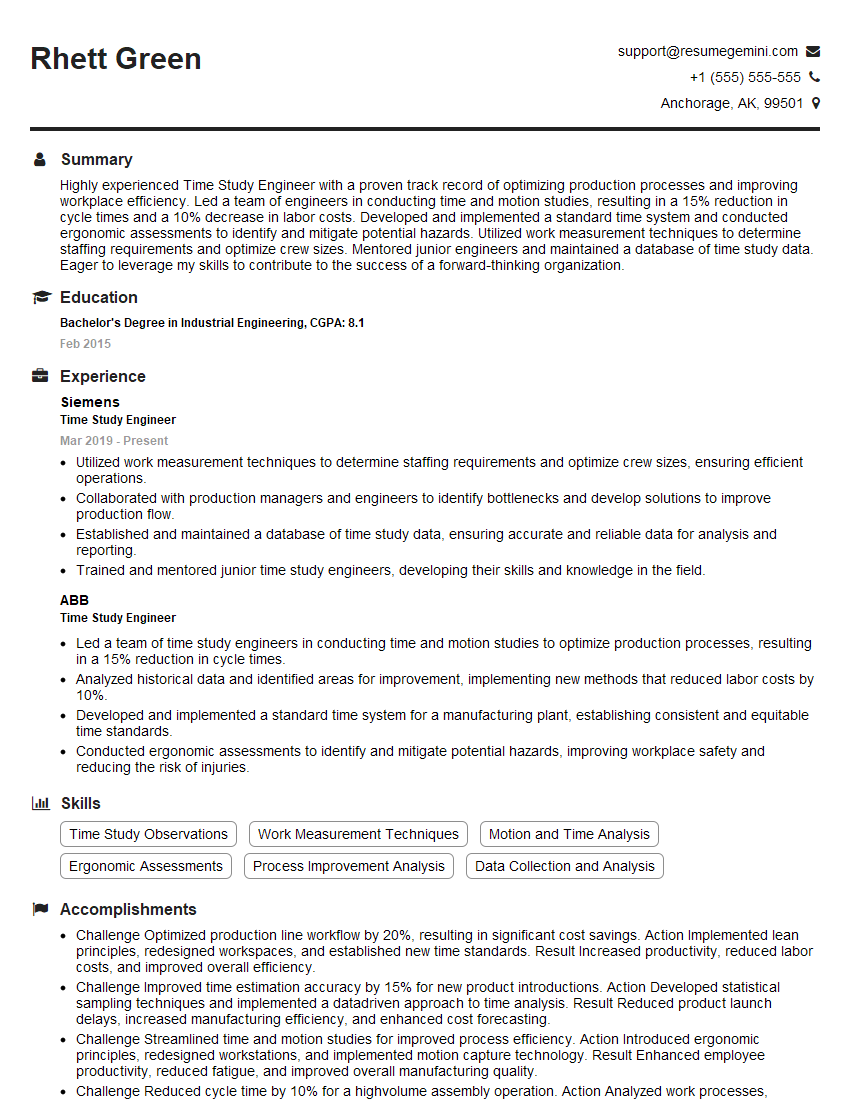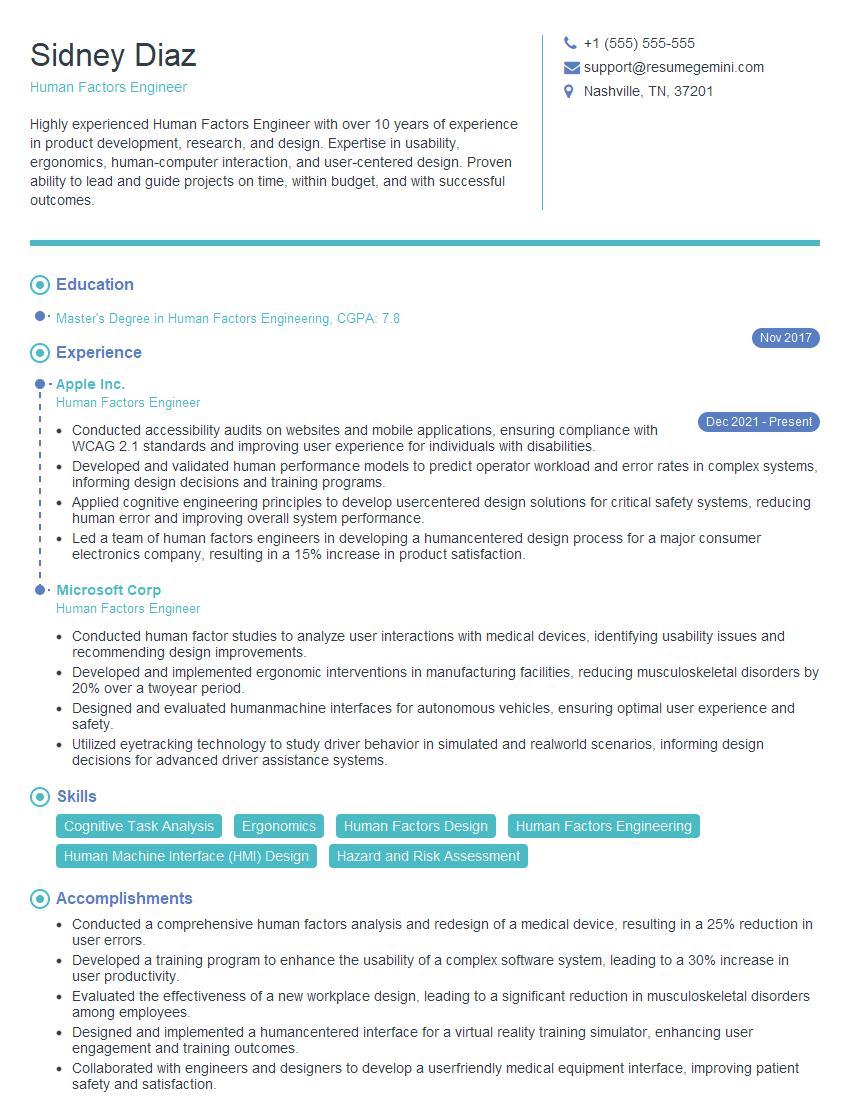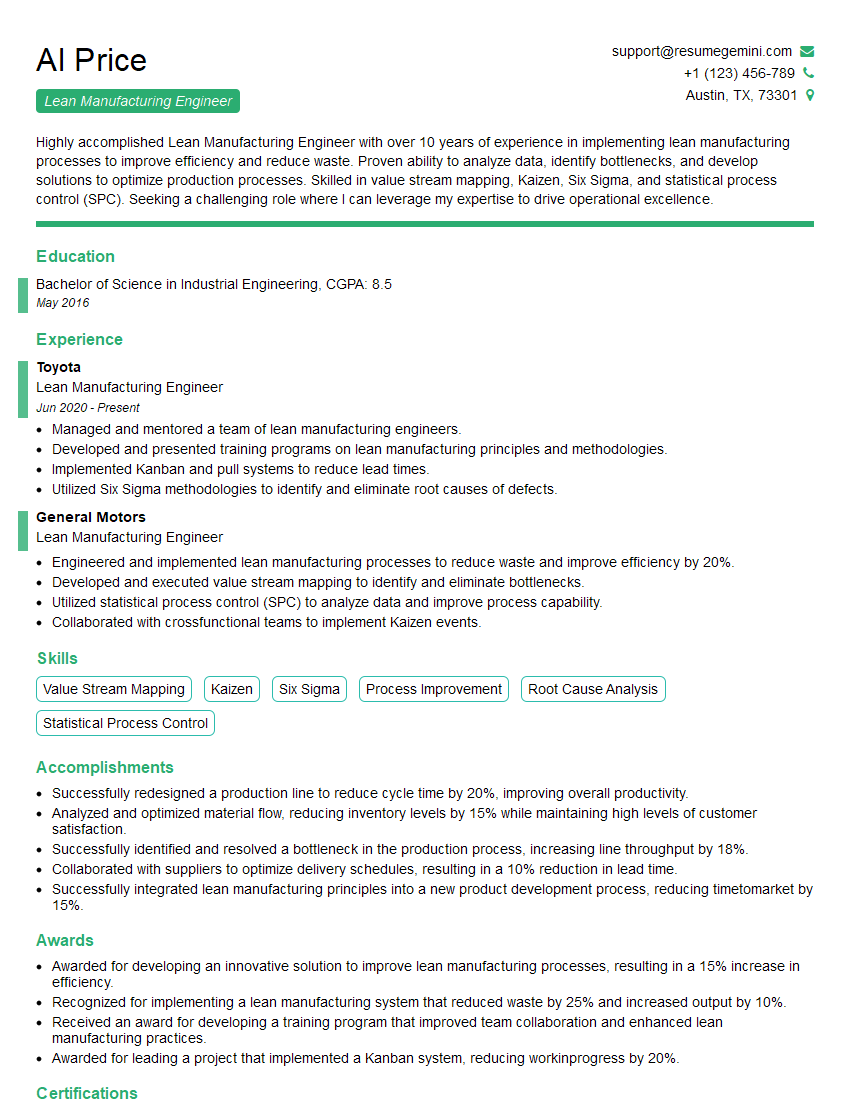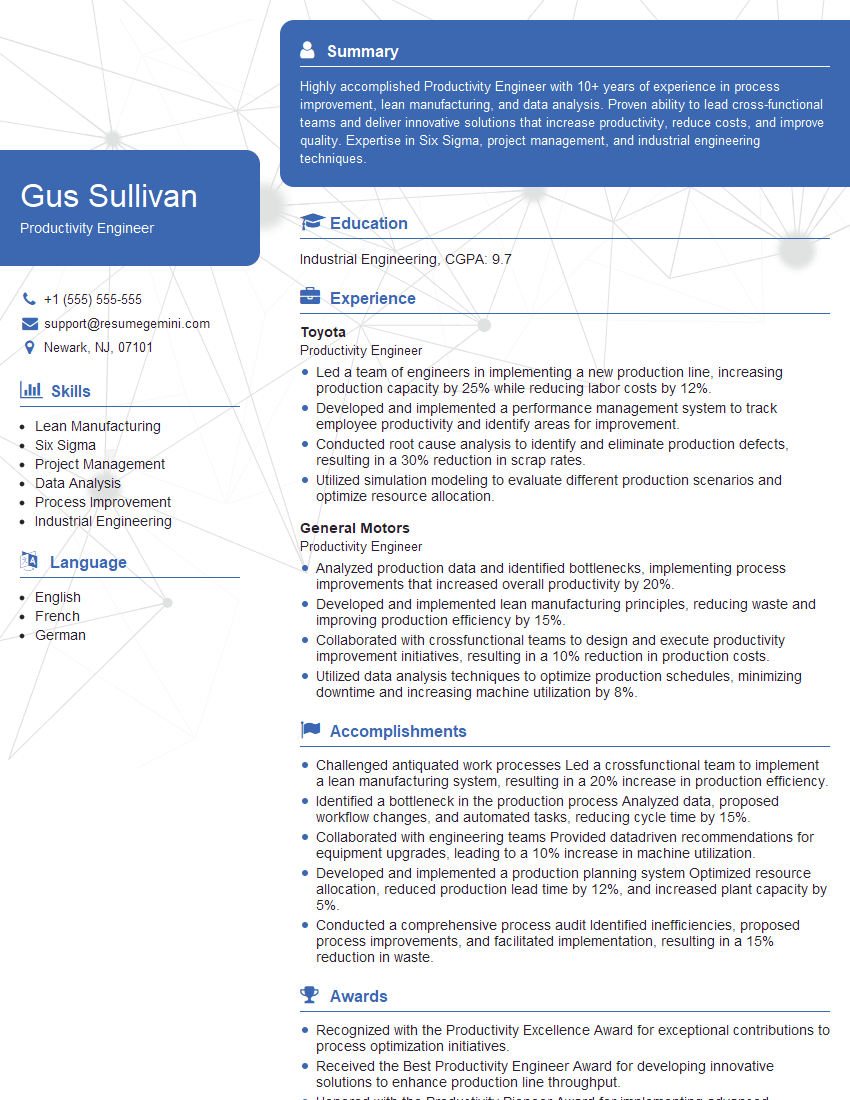Feeling uncertain about what to expect in your upcoming interview? We’ve got you covered! This blog highlights the most important Time Study and Work Measurement interview questions and provides actionable advice to help you stand out as the ideal candidate. Let’s pave the way for your success.
Questions Asked in Time Study and Work Measurement Interview
Q 1. Explain the difference between time study and work measurement.
While both time study and work measurement aim to determine the time required to complete a task, they differ in scope and methodology. Time study is a direct observation technique that measures the actual time taken by a worker to perform a task under specific conditions. It’s a detailed, granular approach focusing on individual elements of the job. Work measurement, on the other hand, is a broader concept encompassing various methods – including time study, predetermined motion time systems (PMTS), and work sampling – to establish standard times for tasks. Think of time study as one tool within the larger toolbox of work measurement.
For example, imagine you’re analyzing the time taken to assemble a widget. Time study would involve directly observing an assembler, recording the time for each step (e.g., picking up a screw, inserting it, tightening it). Work measurement might use this time study data along with other methods to create a comprehensive standard time for the entire widget assembly, considering factors like fatigue and allowances.
Q 2. Describe the various methods used in time study.
Several methods are used in time study, each with its strengths and weaknesses:
- Continuous Time Study: The observer continuously records the time taken for each element of the task. This method is suitable for tasks with clearly defined elements and relatively short cycle times.
- Snap-back Time Study: The observer records the time for each element and immediately resets the stopwatch to zero before starting the next element. This technique is useful for tasks with variable cycle times or when there are interruptions.
- Work Sampling: A statistical technique where random observations are made to determine the proportion of time spent on different elements of a task. This is helpful for long-cycle tasks where continuous observation is impractical.
- Video Recording: Recording the task allows for later analysis and multiple review opportunities, enhancing accuracy and reducing observer bias. It is particularly useful for analyzing complex tasks.
The choice of method depends on factors such as the complexity of the task, the cycle time, and the availability of resources. For instance, continuous time study might be best for a simple repetitive task on an assembly line, while work sampling could be more appropriate for observing a manager’s activities throughout the day.
Q 3. What are the advantages and disadvantages of using predetermined time systems?
Predetermined Time Systems (PTS), such as Methods-Time Measurement (MTM) and Basic Motion Time Study (BMT), use predefined times for basic human motions. These systems offer advantages and disadvantages:
- Advantages:
- Faster than direct time study: PTS can be used to estimate times before the task is even performed, useful for planning and design purposes.
- Reduces observer bias: Eliminates the subjective element of direct observation.
- Useful for designing improved methods: PTS can help analyze and improve task efficiency by identifying unnecessary motions.
- Disadvantages:
- Requires expertise: Accurate use requires trained analysts familiar with the specific system’s database.
- May not accurately reflect real-world conditions: Assumptions about worker skill and environmental factors might not always be realistic.
- Can be costly to implement: Initial training and database acquisition can be significant investments.
For example, MTM might be used to analyze the time for a hand movement to reach and grasp an object, thereby allowing an overall time estimation for the entire operation, regardless of the specific worker.
Q 4. How do you handle unusual or infrequent occurrences during a time study?
Unusual occurrences during a time study must be handled carefully to ensure the accuracy of the data. These occurrences, such as machine breakdowns, material shortages, or unexpected delays, are typically classified as either allowable or unallowable.
- Allowable occurrences (e.g., short, unavoidable delays) are incorporated into the standard time using allowances. For example, a short delay waiting for a machine to cycle is acceptable and can be factored into the final standard time with fatigue and personal allowances.
- Unallowable occurrences (e.g., extended machine downtime, major errors) are excluded from the study. The study might be repeated or the affected observations excluded from the calculation. The key is to ensure that the data only reflects the time for the work itself, under normal and expected circumstances.
A detailed log of any unusual occurrences, including their nature, duration, and cause, is essential. This documentation provides transparency and helps to justify any decisions made about handling the data.
Q 5. Explain the concept of standard time and how it’s calculated.
Standard time represents the time a qualified worker should take to perform a task at a defined performance level, considering factors that influence work pace. It’s calculated by adjusting the observed time to account for various allowances.
The calculation typically follows these steps:
- Record the observed time: Obtain the average time from multiple observations of the task.
- Rate the performance: Assess the worker’s performance relative to a standard, typically expressed as a percentage of normal performance (e.g., 100%).
- Adjust for performance: Divide the observed time by the performance rating (expressed as a decimal). For example, an observed time of 10 minutes with a 110% performance rating yields a normal time of 10/1.10 = 9.09 minutes.
- Apply allowances: Add allowances for personal needs, fatigue, and unavoidable delays. Allowances are usually expressed as percentages. For example, a 15% allowance on a normal time of 9.09 minutes gives 9.09 * 1.15 = 10.45 minutes.
The result is the standard time for the task: in our example, 10.45 minutes.
Q 6. What are the key elements of a good work measurement program?
A successful work measurement program hinges on several key elements:
- Clearly defined objectives: The program should have specific, measurable, achievable, relevant, and time-bound (SMART) goals. For example, reduce production time by 10% within 6 months.
- Proper planning and preparation: Thorough job analysis, selection of appropriate methods, and training of personnel are crucial.
- Accurate data collection and analysis: Use reliable methods and maintain meticulous records. Regularly review and update data to reflect changes in processes or technology.
- Fair and consistent application: Ensure that the methods are applied consistently across all tasks and workers, avoiding bias.
- Feedback and communication: Regularly communicate the results of the program to workers and management. This fosters trust and buy-in.
- Continuous improvement: Work measurement is not a one-time event. The program should be regularly reviewed and updated to reflect changes in processes and technology.
Q 7. How do you ensure accuracy and reliability in time study data?
Ensuring accuracy and reliability in time study data requires meticulous attention to detail throughout the entire process:
- Select representative workers: Choose workers with average skills and experience. Avoid selecting exceptionally fast or slow workers.
- Conduct multiple observations: More observations improve the reliability of the average time. The number of observations needed depends on the variability of the task.
- Use appropriate equipment: Accurate stopwatches or electronic timing devices are essential.
- Minimize observer bias: The observer should be trained to avoid influencing the worker’s performance.
- Record all relevant information: Document all details, including task descriptions, environmental conditions, and any unusual occurrences.
- Verify data integrity: Check for errors in data entry and calculations.
- Use statistical techniques: Analyze the data statistically to identify outliers and ensure the reliability of the results.
Employing techniques such as stratified sampling, which involves selecting observations from various subgroups within the population, further improves data representativeness and accuracy.
Q 8. What are the potential sources of error in time study?
Time studies, while powerful tools for work measurement, are susceptible to various errors. These errors can broadly be categorized into observer errors, worker errors, and environmental errors.
- Observer Errors: These stem from the limitations of the person conducting the study. For example, an observer might inadvertently miss elements of the task, incorrectly record times, or be biased in their performance rating. Imagine an observer consistently underestimating the time required for a particularly complex step because they are unfamiliar with the process. This leads to inaccurate data and potentially flawed conclusions about standard times.
- Worker Errors: Workers themselves might introduce errors. They may consciously or unconsciously work at a different pace during observation (e.g., trying to impress or being fatigued). Inconsistencies in materials or equipment can also affect cycle times, which are then reflected in the data. Let’s say a worker is dealing with a malfunctioning tool – the time taken to complete the task will be skewed, not reflecting normal working conditions.
- Environmental Errors: External factors like interruptions (phone calls, unexpected delays), changes in the work environment (temperature, lighting), or variations in material quality can all affect the observed times. For instance, a sudden power outage during a time study will significantly disrupt the data and require significant adjustments or even repetition of the study.
Minimizing these errors requires careful planning, well-trained observers, standardized procedures, and rigorous data validation.
Q 9. How do you deal with worker variability in time study data?
Worker variability is a significant challenge in time study. People naturally work at different speeds and efficiencies. To address this, we employ statistical methods. The most common approach is to take multiple observations (at least 10-20) of the same task performed by the same worker, or even by different workers of similar skill levels. This allows us to calculate the average time for each worker.
We then analyze the data for outliers – unusually high or low times. These might indicate errors in observation, unusual circumstances during the observation, or simply a less representative observation. Outliers are usually excluded from the analysis after careful review. Once outliers are removed we can calculate the average time and the standard deviation. The standard deviation gives us a measure of the variability in the worker’s performance. The resulting data, then, presents a more reliable understanding of the typical time required to complete the task.
In addition to statistical methods, rating factors are applied to adjust for individual differences in worker skill and effort (as we’ll discuss in the next question). It’s also important to clearly define the standard of performance expected, ensuring consistency in observed work methods and conditions.
Q 10. Explain the concept of performance rating and its importance.
Performance rating is a crucial aspect of time study. It’s the process of assessing the observed worker’s performance relative to a defined standard, usually a ‘normal’ or ‘average’ performance level. The standard performance level is considered to represent the pace and effort that a skilled, qualified worker should reasonably maintain over a full working day.
Imagine a painter carefully painting a wall. If they work exceptionally fast and efficiently, their rating will be above 100%. Conversely, if they work slowly or make unnecessary errors, their rating will be below 100%. This rating isn’t about judging the worker’s skill or productivity; rather, it is about adjusting the observed time to reflect what the time would be for the ‘average’ worker performing the task under the same conditions.
The importance of performance rating lies in its ability to ensure that the final standard time represents a fair and achievable standard, eliminating biases stemming from individual worker differences. This prevents setting unrealistic or unfair production targets for workers.
Q 11. Describe different performance rating methods.
Several methods exist for performance rating. They range from subjective approaches relying heavily on the observer’s judgment to more objective methods.
- Speed Rating: This is a subjective method where the observer visually compares the worker’s pace to their perception of a ‘normal’ pace. The observer assigns a rating, typically as a percentage of normal pace, based on this comparison.
- WestingHouse System: This is a more structured subjective method, using a rating scale and providing more specific descriptors of performance levels to guide the observer.
- Synthetic Rating: In this method, the observer assesses various aspects of the worker’s performance separately, such as skill, effort, and working conditions, and then combines these ratings to get an overall performance rating.
- Objective Methods: In recent years, there has been increasing use of objective methods, including video analysis and electronic performance measurement devices. These methods offer a potentially more accurate and less subjective measurement of worker performance.
The choice of method depends on factors such as the complexity of the task, the level of observer experience, and the required accuracy. A combination of methods may be used for better accuracy and consistency.
Q 12. What are the ethical considerations in conducting time studies?
Ethical considerations are paramount in time studies. The primary ethical concern is ensuring fairness and transparency. It is crucial to avoid using time studies to exploit workers or set unrealistic expectations. Workers should be fully informed about the purpose of the study, the data collection methods, and how the results will be used.
Informed consent is vital. It’s unethical to conduct a time study without the worker’s knowledge and agreement. Furthermore, the study should be conducted in a way that doesn’t unduly pressure or stress the worker. The results shouldn’t be used to justify unfair wage cuts or excessive workloads. They should be used to improve processes, improve worker efficiency, and increase overall productivity without compromising worker safety or well-being.
Confidentiality of data is another crucial aspect. Individual worker performance data should be kept confidential, used solely for improving processes, and not shared with others inappropriately. It’s crucial to establish clear guidelines and protocols to maintain this confidentiality.
Q 13. How do you present time study findings to management?
Presenting time study findings to management requires a clear, concise, and visually compelling approach. The presentation should begin with a summary of the study’s objectives and methodology. Then, use visuals like charts and graphs to illustrate key findings. Avoid presenting raw data; rather, focus on the derived standard times, production rates, and potential improvements identified by the study.
For example, a bar chart could compare the current average time to complete a task with the new standard time, highlighting efficiency gains. Tables can effectively present standard times for various tasks. It’s also useful to include a discussion of the potential impact on productivity, cost savings, or production capacity.
Finally, present recommendations based on the findings. This might include proposals for process improvements, better work scheduling, or employee training programs that will improve overall operational efficiency. Remember to make it clear how the time study data supports those recommendations. The overall goal is to demonstrate how the findings can support informed decision-making and improve organizational efficiency.
Q 14. Explain the relationship between time study and work simplification.
Time study and work simplification are closely related, yet distinct, concepts. Time study focuses on measuring the time required to perform a task, while work simplification aims to improve the efficiency of that task. They work together synergistically.
A time study might reveal that a particular task is unusually time-consuming. This finding could then prompt a work simplification analysis, seeking ways to reduce wasted time, eliminate unnecessary movements, or improve the workflow. Once improvements are implemented through work simplification, a new time study would be conducted to measure the impact of those changes, quantifying the efficiency gains achieved. Therefore, time study provides the quantitative data that justifies and measures the impact of work simplification initiatives. Consider it a before-and-after measurement for continuous improvement.
For example, a time study could reveal that a certain assembly process takes too long. Work simplification techniques might then be used to reorganize the workspace, redesign the tools, or improve the sequence of operations to shorten the cycle time. Subsequent time studies would then confirm the efficiency improvements resulting from the work simplification.
Q 15. How do you determine the appropriate sample size for a time study?
Determining the appropriate sample size for a time study is crucial for ensuring the accuracy and reliability of your results. A sample that’s too small might not represent the true variability of the task, leading to inaccurate standards. Conversely, an overly large sample wastes time and resources. The ideal sample size depends on several factors, including the desired level of accuracy, the variability of the task, and the acceptable margin of error.
Several methods exist for determining sample size. One common approach involves using statistical methods to calculate the number of observations needed to achieve a specific confidence interval and margin of error. This usually requires estimating the variability (standard deviation) of the task times. Software packages and statistical tables can assist with this calculation. For instance, if you’re aiming for a 95% confidence interval and a 5% margin of error, and you have an estimate of the standard deviation of the task times, you can use statistical formulas to calculate the necessary sample size. Often, a pilot study is conducted to obtain a preliminary estimate of the standard deviation before calculating the final sample size.
Another approach considers the cost-benefit trade-off. A larger sample size reduces the risk of error, but comes with the cost of increased time and resources for data collection and analysis. A pragmatic approach often involves choosing a sample size that balances these competing factors. A rule of thumb that’s sometimes used, though not a replacement for proper statistical methods, suggests observing at least 30 cycles of the task. However, this is purely heuristic and is highly dependent on the context.
For example, in a manufacturing setting, if we’re timing the assembly of a complex product, a larger sample size might be needed compared to timing a simpler task. The variability in assembly time for a complex product might be much higher, requiring more observations to get a reliable estimate.
Career Expert Tips:
- Ace those interviews! Prepare effectively by reviewing the Top 50 Most Common Interview Questions on ResumeGemini.
- Navigate your job search with confidence! Explore a wide range of Career Tips on ResumeGemini. Learn about common challenges and recommendations to overcome them.
- Craft the perfect resume! Master the Art of Resume Writing with ResumeGemini’s guide. Showcase your unique qualifications and achievements effectively.
- Don’t miss out on holiday savings! Build your dream resume with ResumeGemini’s ATS optimized templates.
Q 16. How do you incorporate allowances into standard time calculations?
Allowances are crucial in time study because they account for factors that influence a worker’s performance beyond the basic work content. They represent the time a worker needs for things like personal needs, fatigue, unavoidable delays, and other factors not directly related to the task itself. Incorporating allowances ensures that the standard time accurately reflects the time a worker realistically requires to complete a task. Failing to do so can lead to unrealistic expectations and worker dissatisfaction.
Allowances are usually expressed as percentages and are added to the normal time to obtain the standard time. The formula is simple:
Standard Time = Normal Time × (1 + Allowance Percentage)
For example, if the normal time for a task is 10 minutes, and we have a total allowance of 15% (this is often the sum of individual allowances – see the next question), then:
Standard Time = 10 minutes × (1 + 0.15) = 11.5 minutes
The allowance percentage is determined based on the various allowances assigned for the specific task, which is a complex process often involving consultation with workers and industrial engineering experts. It’s crucial to use appropriate and well-justified allowance percentages to create fair and achievable work standards.
Q 17. What are different types of allowances used in time study?
Several types of allowances are used in time study, each representing a different aspect of the work environment and worker needs. These allowances are usually added together to give a total allowance percentage. Common allowance types include:
- Personal Needs Allowance: This accounts for the time needed for restroom breaks, stretching, etc. A typical value might be 5%.
- Fatigue Allowance: This compensates for the physical and mental fatigue that accumulates over time. The magnitude is task-specific and often higher for physically demanding tasks.
- Delay Allowance: This covers unavoidable delays caused by equipment malfunctions, material shortages, or other unexpected interruptions. This is often difficult to estimate and may require detailed observation.
- Contingency Allowance: This adds a buffer for unexpected events or variations that were not accounted for in the other allowances. It acts as a safeguard against overly tight standards.
- Learning Allowance: Used for new tasks or when a significant skill change is introduced, allowing for time to learn a process. It reduces over time as the worker gains proficiency.
The specific allowances and their percentages used will depend heavily on the nature of the task, the working conditions, and company policy. A well-structured allowance policy will clearly document how each allowance is determined. For example, a heavy lifting task might have a much higher fatigue allowance than a desk-based job.
Q 18. Describe the process of developing work standards.
Developing work standards is a systematic process that involves several key steps. The goal is to establish a fair and achievable time for completing a specific task, considering both the work content and the various allowances discussed previously. These standards are fundamental for planning, scheduling, cost estimating, performance evaluation, and process improvement.
- Method Study: This initial step involves analyzing the current work method to identify and eliminate inefficiencies. Techniques like flow process charts, operation process charts, and motion studies are employed to optimize the work process before timing begins.
- Time Study: This involves systematically measuring the time taken to perform the task, using stopwatches or electronic timing devices. Multiple observations are taken to account for variability. The observed times are then adjusted for performance rating (discussed later).
- Performance Rating: The observed times are rated to adjust for the skill and pace of the worker being observed. A rating of 100% implies that the worker is working at a standard pace. Ratings above or below 100% adjust for faster or slower work.
- Calculation of Normal Time: The adjusted time (after performance rating) is the normal time, representing the time a worker should take to complete the task at the standard pace.
- Incorporation of Allowances: As discussed earlier, appropriate allowances are added to the normal time to determine the standard time.
- Standard Time Determination: This is the final output of the process – the total time, including allowances, that a worker should take to complete the task. This standard is then used as a benchmark for performance evaluation and other management purposes.
- Standard Setting and Communication: The final standards should be clearly communicated to workers, ensuring they understand and agree with the set times. Feedback is incorporated to ensure that the standard is fair and achievable.
The entire process requires careful planning, attention to detail, and effective communication throughout the organization. This ensures acceptance and equitable application of the standards set.
Q 19. How do you use work measurement data to improve productivity?
Work measurement data provides valuable insights into the efficiency of operations and offers opportunities for productivity improvement. By analyzing the data, we can identify bottlenecks, inefficiencies, and areas for process optimization. Here’s how:
- Identify Bottlenecks: Analyzing the standard times for various tasks can pinpoint stages in a process that are significantly slower than others. This information helps to prioritize improvement efforts on the most critical bottlenecks.
- Improve Work Methods: Time study data can reveal inefficiencies in the work method itself. By comparing different methods, or by carefully analyzing motion patterns, we can identify opportunities for streamlining operations.
- Reduce Waste: The data can highlight wasted time due to delays, idle time, or unnecessary steps. This allows for targeted actions to eliminate sources of waste.
- Set Realistic Goals: Accurate standard times provide a basis for setting realistic production targets and performance expectations.
- Improve Capacity Planning: Using standard times helps to estimate staffing needs more accurately and efficiently schedule resources.
- Employee Training and Development: By identifying areas where workers struggle, we can design training programs that focus on improving specific skills and knowledge.
- Evaluate Equipment Performance: Work measurement data can help assess the impact of equipment on worker productivity and support investment decisions for new equipment or technology.
For example, if a time study reveals that a particular machine is causing significant delays, management can decide to invest in a faster machine or implement improved maintenance procedures to reduce downtime. Similarly, if a task is consistently taking longer than the standard time, it might indicate a need for retraining or better work instructions.
Q 20. Explain the concept of MOST (Maynard Operation Sequence Technique).
MOST (Maynard Operation Sequence Technique) is a predetermined motion time system (PMTS) used for work measurement. Unlike traditional time studies that rely on direct observation and performance rating, MOST uses pre-defined time values for basic human movements. This makes it quicker and more consistent than traditional time studies, particularly for tasks that involve a series of discrete movements.
MOST breaks down tasks into a series of basic motions (called ‘basic motions’ or ‘basic motion elements’) and uses standardized time values for each of those movements. These basic motions consider factors such as the distance moved, the weight of the object, and the precision required. The system is comprised of several predefined basic motion elements, such as reach, grasp, move, position, release, and others. It has tables and diagrams that help determine the times associated with the movement.
The process involves describing the task using MOST’s predefined terms, and then selecting the appropriate motions and their corresponding times from MOST’s data tables. The sum of all the times gives the total time required for the task. A key advantage is that it doesn’t require direct observation of the worker. A detailed description is sufficient for analysis.
MOST is particularly useful for designing new work methods or evaluating alternative methods because it allows for the analysis of potential motions before they are physically performed. It’s used extensively in designing workstations and creating more efficient operational procedures in manufacturing, industrial, and service settings.
Q 21. What is the difference between subjective and objective performance rating?
The difference between subjective and objective performance rating lies in how the rating is obtained. Both methods aim to assess the speed and effectiveness of a worker performing a task relative to a standard pace, but they differ significantly in their methodology.
Subjective Performance Rating: This method relies on the time study analyst’s judgment to assess the worker’s performance. The analyst observes the worker, comparing their speed and effectiveness to their internalized concept of a ‘normal’ or ‘standard’ pace. The analyst then assigns a rating (e.g., a percentage) that represents the worker’s performance relative to this standard. This is a qualitative assessment and introduces the potential for bias and inconsistency, even if the analyst is experienced.
Objective Performance Rating: This method aims to minimize subjectivity by using objective data to assess worker performance. This might involve using electronic timing devices, motion analysis systems, or even analyzing video recordings of the work. Objective data like cycle times, acceleration patterns, or the number of movements are collected and used to derive a performance rating. The system might even be calibrated against the subjective ratings obtained from experienced time-study experts. While completely objective rating is usually not possible, using objective data minimizes the effect of analyst bias and improves consistency.
In practice, a blend of both subjective and objective approaches is often used to improve accuracy and reduce bias. For example, an analyst might use video recordings of the task to supplement their subjective rating of the worker’s performance, improving the accuracy and objectivity of the final performance assessment.
Q 22. How do you ensure the acceptance of new work standards by employees?
Gaining employee acceptance of new work standards is crucial for a successful work measurement program. It’s not just about imposing new numbers; it’s about fostering a collaborative environment where employees understand the ‘why’ behind the changes and feel valued in the process.
My approach involves several key steps:
- Transparency and Communication: I begin by clearly explaining the purpose of the time study and how the new standards were derived. This often involves demonstrating the data collection methods, showing the calculations, and highlighting the benefits—such as improved efficiency, fair compensation, or reduced workload.
- Employee Involvement: I actively involve employees in the process. This could involve having them participate in the time study observations, providing feedback on the methodology, or even suggesting improvements to the process itself. This sense of ownership significantly increases buy-in.
- Training and Support: Thorough training on the new standards and any associated changes in procedures is vital. This includes hands-on training and ongoing support to ensure employees feel comfortable with the new processes.
- Addressing Concerns: I create a safe space for employees to express their concerns and address them proactively. This might involve addressing fears about job security, increased workload, or perceived unfairness. Open communication and demonstrating empathy are critical here.
- Incentives and Recognition: Depending on the company culture and the nature of the changes, offering incentives or recognition for meeting or exceeding the new standards can positively reinforce the new norms.
For example, in a recent project implementing new standards for a packaging line, I involved the line workers in the initial time study, explained how the new standards would lead to shorter cycle times and better ergonomics, and provided additional training on the new packaging procedures. This resulted in smooth implementation and improved team morale.
Q 23. How do you handle resistance to change during work measurement implementation?
Resistance to change during work measurement implementation is common, stemming from fear of the unknown, perceived job threats, or past negative experiences with similar initiatives. Addressing this requires a sensitive and strategic approach.
My strategy involves:
- Proactive Communication: Early and frequent communication about the upcoming changes, their rationale, and their potential benefits significantly reduces anxiety and fosters understanding.
- Addressing Concerns: Creating channels for employees to voice their concerns and actively listening to their feedback is crucial. Concerns should be addressed with empathy and appropriate solutions found.
- Pilot Programs: Starting with a pilot program in a small area allows for testing the new system, identifying potential issues, and making adjustments before full-scale rollout. This reduces the risk and allows for iterative improvements.
- Training and Support: Comprehensive training helps employees adapt to new methods and build confidence. Ongoing support and access to knowledgeable resources minimize frustration.
- Collaboration and Negotiation: Working collaboratively with employees, managers, and union representatives (if applicable) to negotiate and adjust the new standards where necessary can significantly enhance buy-in. Flexibility and willingness to compromise often yields better results.
- Change Management Framework: Employing a structured change management approach (e.g., Kotter’s 8-step process) helps navigate the transition effectively, managing expectations and addressing potential resistance at each stage.
In one instance, I encountered resistance to a new standard for assembly tasks due to concerns about increased workload. By involving the team in refining the standard, addressing their ergonomic concerns by adjusting workstation design, and offering additional training, we successfully navigated the resistance and ultimately achieved a more efficient and safer working environment.
Q 24. Describe your experience with different time study software.
My experience spans several time study and work measurement software packages. Each has its strengths and weaknesses, making the choice dependent on the specific needs of the project and organization.
I have extensive experience with:
- Method-Time Measurement (MTM) software: These programs offer pre-defined data for basic movements, allowing for quick and relatively accurate time estimates, particularly beneficial for repetitive tasks. I’ve used several MTM software packages including those from MTM Association and others that integrate with broader ERP systems. Their strength lies in consistency and speed for standardized tasks but they may be less adaptable to highly variable or complex work.
- Most Commonly Used Software Packages: Many companies use customized solutions or integrate time study data with broader enterprise resource planning (ERP) systems. This allows for better data integration and workflow management. Specific software names vary but often include features for data capture, analysis, and reporting.
- Video and Motion Analysis Software: These tools facilitate detailed observations and analyses of worker movements, supporting more in-depth studies and improvements in ergonomics. Software packages range from simpler video recording and playback tools to advanced motion capture and biomechanical analysis software. These are particularly useful for detailed, complex processes or when investigating ergonomics concerns.
The key is selecting software that aligns with the complexity of the tasks, the data requirements, and the organization’s overall system architecture. I’m proficient in adapting my methods to effectively leverage the capabilities of different software packages.
Q 25. How do you ensure the safety of workers during time study observations?
Worker safety is paramount during time studies. Neglecting safety can lead to accidents and injuries, undermining the entire process. My approach emphasizes safety at every stage:
- Pre-Study Risk Assessment: I conduct a thorough risk assessment of the work process before commencing the time study, identifying potential hazards and implementing appropriate control measures. This includes reviewing existing safety procedures and potentially consulting with safety professionals.
- Proper Observation Techniques: Observations are conducted in a way that minimizes disruption to the worker’s routine and avoids putting them at risk. Observers maintain a safe distance and avoid distracting the worker. For hazardous operations, remote observation or specialized equipment might be necessary.
- Personal Protective Equipment (PPE): Workers are required to use appropriate PPE throughout the time study, consistent with their normal work practices. The observer should also wear appropriate PPE if necessary.
- Emergency Procedures: Clear emergency procedures are established and communicated to both the worker and the observer. This includes knowing the location of emergency exits, first-aid kits, and emergency contact information.
- Worker Training: The worker conducting the task should be properly trained and competent in their work, ensuring they are aware of all safety procedures before the time study begins.
- Regular Breaks: Frequent breaks are provided to the worker to avoid fatigue, a major contributing factor to accidents. Time study protocols should account for realistic break times.
For instance, in a study involving heavy machinery, I ensured the worker adhered to all lockout/tagout procedures, utilized safety harnesses, and maintained a safe distance during the study. Safety is not an afterthought; it is integrated into the design and execution of every time study.
Q 26. Explain the impact of technology on time study and work measurement.
Technology has revolutionized time study and work measurement, increasing efficiency, accuracy, and providing more insightful data.
The impact is seen in several ways:
- Automated Data Collection: Software and sensors can automatically record task times and other relevant data, eliminating manual data entry errors and reducing the time required for data collection. This might involve RFID tags, machine sensors, or integrated software.
- Video and Motion Analysis: High-resolution video recording and sophisticated motion capture software provide detailed information about worker movements, allowing for identification of inefficiencies and ergonomic improvements. Software often allows for detailed analysis of posture, movement speed, and potential risk factors.
- Virtual Reality (VR) and Simulation: VR technology enables the simulation of work processes before physical implementation, helping to optimize processes and identify potential issues early on. This reduces costly physical prototyping and iterations.
- Advanced Analytics: Sophisticated statistical techniques and data analysis software can identify patterns and trends in the data, providing deeper insights into worker productivity and process improvements. Machine learning algorithms can even predict potential bottlenecks or failures.
- Cloud-Based Platforms: Cloud-based platforms offer centralized data storage, accessibility, and collaboration features, facilitating streamlined workflows and improved team communication.
For example, using automated data collection from a robotic assembly line drastically reduced the time and effort required for data gathering and enabled quicker identification of bottlenecks in the production flow.
Q 27. How do you measure the effectiveness of a work measurement program?
Measuring the effectiveness of a work measurement program requires a multifaceted approach, looking beyond just improved productivity. Key metrics include:
- Productivity Improvement: This is a primary metric, comparing output before and after the implementation of new standards. It’s important to consider not just overall output but also the efficiency of individual processes.
- Reduced Costs: A successful program should lead to reductions in labor costs, material costs, or overhead. Careful analysis of these factors is important to show overall cost savings.
- Improved Quality: Work measurement should not compromise quality. The program’s effectiveness should be evaluated by assessing changes in defect rates, error rates, or customer satisfaction.
- Employee Satisfaction: A successful work measurement program doesn’t just improve productivity; it should also lead to increased employee satisfaction. This can be assessed through surveys, feedback sessions, and observation of worker morale.
- Safety Improvements: A well-executed program should contribute to a safer work environment. This can be measured by tracking accident rates, near misses, or lost-time injury rates.
- Return on Investment (ROI): The overall effectiveness of the program needs to be assessed by evaluating its return on investment. This considers initial investment in software, training, and time, weighed against the long-term cost savings and productivity gains.
For instance, after implementing a work measurement program in a manufacturing facility, we not only saw a 15% increase in productivity but also a 10% reduction in defect rates and improved employee morale, demonstrating the program’s overall effectiveness.
Q 28. Describe a situation where you had to troubleshoot a problem during a time study.
During a time study of a complex assembly process, we encountered a significant discrepancy in the observed times between different workers. Initially, we suspected inconsistent work methods or variations in the task itself.
Our troubleshooting process involved:
- Review of Data Collection Methods: We reviewed our data collection methodology, ensuring consistency and accuracy. This involved verifying the time recording tools and ensuring that all observations were properly documented.
- Detailed Work Breakdown: We broke down the assembly process into smaller, more manageable elements to identify where the variations were occurring. This revealed that one step, involving the precise alignment of small components, was significantly more time-consuming for some workers than others.
- Observation of Workers: We closely observed the workers performing the task, paying attention to their techniques and identifying potential sources of variation. We found that some workers had developed more efficient techniques for the tricky alignment step.
- Process Improvement: Based on our findings, we collaborated with the workers to improve the alignment process. This included redesigning the workstation to improve ergonomics and providing additional training on the most efficient alignment techniques. This not only addressed the time discrepancies but also improved worker comfort and safety.
- Refinement of the Standard: We refined our time standard to account for the revised process and the distribution of worker performance. This resulted in a more accurate and realistic standard.
This situation highlighted the importance of detailed observation, thorough data analysis, and collaborative problem-solving in work measurement. It demonstrated that sometimes, apparent inconsistencies can point towards areas for process improvement and ergonomic enhancements.
Key Topics to Learn for Time Study and Work Measurement Interview
- Time Study Fundamentals: Understanding the principles of time study, including selecting representative tasks, recording observations, and analyzing data.
- Work Measurement Techniques: Mastering various techniques like stopwatch time study, predetermined motion time systems (PMTS), and work sampling, and knowing when to apply each.
- Performance Rating: Learning to accurately assess worker performance levels, considering factors like skill, effort, and consistency, and understanding different rating methods.
- Allowance Factors: Calculating and applying allowances for personal needs, fatigue, and delays to obtain a fair and realistic standard time.
- Standard Time Calculation: Accurately calculating standard times for various tasks, using appropriate formulas and considering all relevant factors.
- Data Analysis and Interpretation: Analyzing time study data to identify trends, inefficiencies, and areas for improvement; using statistical methods for analysis.
- Work Improvement and Efficiency: Applying time study and work measurement findings to optimize processes, reduce waste, and enhance productivity.
- Method Study and Work Simplification: Understanding the relationship between method study and time study, and how process improvement impacts time standards.
- Technology in Time Study: Familiarizing yourself with software and technologies used in modern time study and work measurement.
- Ethical Considerations: Understanding the ethical implications of time study and work measurement, ensuring fairness and transparency in application.
Next Steps
Mastering Time Study and Work Measurement opens doors to exciting career advancements in operations management, industrial engineering, and many other fields. A strong understanding of these techniques demonstrates valuable skills to potential employers, highlighting your analytical abilities and problem-solving skills. To significantly boost your job prospects, focus on crafting an ATS-friendly resume that effectively showcases your expertise. We highly recommend using ResumeGemini to build a professional and impactful resume tailored to your specific skills and experience. ResumeGemini provides examples of resumes specifically designed for Time Study and Work Measurement professionals, guiding you in presenting your qualifications in the best possible light.
Explore more articles
Users Rating of Our Blogs
Share Your Experience
We value your feedback! Please rate our content and share your thoughts (optional).
What Readers Say About Our Blog
Hi, I’m Jay, we have a few potential clients that are interested in your services, thought you might be a good fit. I’d love to talk about the details, when do you have time to talk?
Best,
Jay
Founder | CEO
